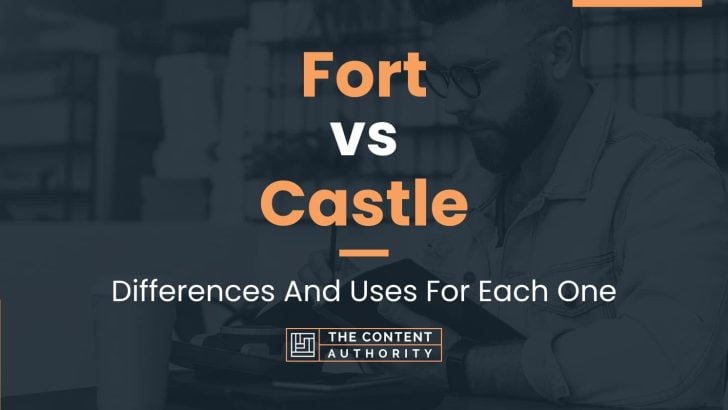Fort vs castle: which one is the proper word? The truth is, both words are correct, but they have different meanings. A fort is a military structure designed to defend against enemy attacks, while a castle is a fortified residence for nobility or royalty.
More specifically, a fort is a defensive structure that is usually smaller and simpler than a castle. It is often built for temporary use during a military campaign and can be made of wood, stone, or other materials. In contrast, a castle is a larger and more elaborate structure that is designed for long-term habitation. It typically includes living quarters, a great hall, and other features that make it suitable for a noble or royal family.
In this article, we will explore the differences between forts and castles in more detail. We will look at the history of these structures, their design and construction, and their role in warfare and society. By the end of this article, you will have a better understanding of the unique characteristics of forts and castles and how they have shaped the course of history.
Define Fort
A fort is a military structure designed to defend against attacks from enemy forces. It is usually a small and simple structure, built for the purpose of providing a secure location for soldiers to defend against enemy attacks. Forts are typically made of stone or brick and are often built on high ground to provide a better vantage point for spotting enemy movements.
Forts are often used in defensive warfare and are built with the intention of withstanding a siege. They are typically equipped with walls, towers, and battlements, and may also have a moat or other obstacle to prevent enemy forces from approaching the fortification.
Examples of famous forts include Fort Ticonderoga in New York and Fort Sumter in South Carolina.
Define Castle
A castle, on the other hand, is a fortified structure that was typically used as a residence for royalty or nobility. Castles are often much larger and more elaborate than forts, with multiple buildings and extensive grounds.
Castles were built for both defensive and offensive purposes. They were designed to withstand long sieges, and often had multiple layers of walls, towers, and moats to make them difficult to breach. Castles also had living quarters, great halls, and other amenities to make them comfortable for their occupants.
Examples of famous castles include Windsor Castle in England and the Château de Versailles in France.
How To Properly Use The Words In A Sentence
When it comes to writing about historical structures, it’s important to use the correct terminology. The words “fort” and “castle” are often used interchangeably, but they have distinct meanings. Here’s how to use them correctly in a sentence.
How To Use “Fort” In A Sentence
A fort is a military structure designed to defend against attacks. It is typically smaller and less ornate than a castle. Here are some examples of how to use “fort” in a sentence:
- The soldiers defended the fort against enemy troops.
- The fort was strategically located on a hilltop.
- The settlers built a wooden fort to protect themselves from Native American attacks.
Note that “fort” is often used in compound words to describe a specific type of fortification, such as “fortress” or “fortification.”
How To Use “Castle” In A Sentence
A castle is a large, fortified building that was often used as a residence for royalty or nobility. It is typically more elaborate and decorative than a fort. Here are some examples of how to use “castle” in a sentence:
- The castle was home to the king and queen.
- The castle was surrounded by a moat filled with alligators.
- The tourists marveled at the castle’s intricate stonework.
Note that “castle” is often used in compound words to describe a specific type of castle, such as “palace” or “chateau.”
More Examples Of Fort & Castle Used In Sentences
In order to better understand the difference between a fort and a castle, it’s important to look at how they are used in sentences. Here are some examples of each:
Examples Of Using “Fort” In A Sentence
- The soldiers were stationed at the fort to protect the border.
- The fort was built in the 1800s to defend against enemy attacks.
- The fort was abandoned after the war ended.
- The fort’s walls were made of stone and were several feet thick.
- The fort’s cannons were used to defend against incoming ships.
- The fort was strategically located on a hill for maximum visibility.
- The fort was a crucial part of the country’s defense system.
- The fort’s barracks housed hundreds of soldiers.
- Visitors can tour the fort and learn about its history.
- The fort’s moat was filled with water to deter attackers.
Examples Of Using “Castle” In A Sentence
- The castle was home to the royal family for centuries.
- The castle’s walls were adorned with intricate carvings.
- The castle was built in the 12th century and still stands today.
- The castle’s drawbridge was raised to keep out unwanted visitors.
- The castle’s dungeons were used to hold prisoners.
- The castle was surrounded by a moat filled with alligators.
- The castle’s towers provided a stunning view of the surrounding countryside.
- The castle’s great hall was used for feasts and celebrations.
- The castle was besieged by enemy forces for months before finally surrendering.
- Visitors can tour the castle and see the lavish furnishings and artwork.
Common Mistakes To Avoid
When it comes to discussing fortifications, the terms “fort” and “castle” are often used interchangeably. However, this is a common mistake that can lead to confusion and miscommunication. Here are some common mistakes to avoid:
Using “Fort” And “Castle” Interchangeably
One of the most common mistakes people make is using “fort” and “castle” interchangeably. While both terms refer to fortified structures, they have distinct differences. A castle is a fortified residence or stronghold, often associated with royalty or nobility. On the other hand, a fort is a military structure designed for defense against enemy attacks.
Using these terms interchangeably can lead to confusion, especially when discussing historical structures. For example, while the Tower of London is often referred to as a castle, it was actually a royal palace and fortress. Similarly, the Alamo is commonly referred to as a fort, but it was actually a mission and fortress.
Assuming All Fortifications Are Medieval
Another common mistake is assuming that all fortifications are medieval. While castles are often associated with medieval Europe, forts have been used throughout history and in various parts of the world. For example, the Great Wall of China is a fortification that dates back to the 7th century BC, while the forts of colonial America were built in the 17th and 18th centuries.
It’s important to remember that fortifications have been used throughout history and in different parts of the world, and that they come in many different forms.
Not Considering Context
Finally, another common mistake is not considering the context in which the terms “fort” and “castle” are being used. While the terms have distinct meanings, they can also be used in a more general sense to refer to any fortified structure. For example, a military base might be referred to as a fort, even if it doesn’t fit the traditional definition of the term.
When using these terms, it’s important to consider the context in which they are being used and to be clear about what is meant by them.
Tips For Avoiding These Mistakes
To avoid these common mistakes, it’s important to:
- Understand the difference between a fort and a castle
- Consider the historical and cultural context in which the terms are being used
- Be clear and specific about what is meant by these terms
By avoiding these common mistakes and being mindful of the differences between “fort” and “castle,” you can communicate more effectively and accurately when discussing fortified structures.
Context Matters
When discussing fortifications, the choice between fort and castle can depend on the context in which they are used. While the terms are often used interchangeably, they can carry distinct connotations and implications.
Examples Of Different Contexts
One context in which the choice between fort and castle might change is the time period being discussed. In the medieval period, a castle was typically a fortified residence for a lord or noble, while a fort was a military structure designed for defense or attack. However, in the modern era, the terms are often used more broadly to refer to any fortified structure.
Another context in which the choice between fort and castle might be influenced is the location of the structure. In Europe, for example, castles were often built on hills or other prominent locations for strategic purposes, while forts were often built on the edges of settlements or along borders. In contrast, in the Americas, forts were often built in remote locations to protect against attacks from native populations, while castles were not present in the same way.
Implications Of The Choice
The choice between fort and castle can also carry implications for the purpose and function of the structure. A castle might suggest a more defensive posture, while a fort might suggest a more aggressive or militaristic intent. Additionally, a castle might be associated with a particular social class or hierarchy, while a fort might be more egalitarian in nature.
Ultimately, the choice between fort and castle depends on the context in which they are used and the implications that the speaker or writer wishes to convey. By understanding the nuances of these terms, we can better appreciate the rich history and culture of fortifications around the world.
Exceptions To The Rules
While the general rule is to use “fort” for military structures and “castle” for residential structures, there are exceptions to this rule. Here are some instances where the rules might not apply:
Castles With Military Functions
There are castles that were built with military functions in mind. These castles were designed to protect the residents from invaders. Examples of these castles include:
- Conwy Castle in Wales
- Dover Castle in England
- Edinburgh Castle in Scotland
While these castles were primarily residential structures, they were also designed to serve a military function. Therefore, it would be appropriate to refer to them as “forts.”
Forts With Residential Functions
There are forts that were built with residential functions in mind. These forts were designed to house military personnel and their families. Examples of these forts include:
- Fort Monroe in Virginia, USA
- Fort Belvedere in England
- Fort York in Canada
While these forts were primarily military structures, they were also designed to serve a residential function. Therefore, it would be appropriate to refer to them as “castles.”
Hybrid Structures
There are some structures that are a combination of a fort and a castle. These structures were built to serve both military and residential functions. Examples of these hybrid structures include:
| Name | Location |
|---|---|
| Château de Chinon | France |
| Castello di Amorosa | California, USA |
| Tower of London | England |
These structures can be referred to as either “forts” or “castles” depending on the context.
Practice Exercises
Now that we have a better understanding of the differences between a fort and a castle, let’s practice using them in sentences. Below are some exercises to help you improve your understanding and usage of these terms:
Exercise 1: Fill In The Blank
Choose the correct word (fort or castle) to fill in the blank in each sentence:
- The soldiers defended the ________ for days without food or water.
- The king and queen lived in a beautiful ________ with a moat and drawbridge.
- The ruins of an old ________ can be seen on the hilltop.
- The ________ was built to protect the city from invaders.
- The medieval ________ was a symbol of power and strength.
Answer Key:
- fort
- castle
- fort
- fort
- castle
Exercise 2: Identify The Structure
Look at the images below and identify whether each structure is a fort or a castle:
 |
 |
 |
 |
Answer Key:
- Fort
- Castle
- Castle
- Fort
By practicing these exercises, you can improve your understanding and usage of fort and castle in your writing and conversation.
Conclusion
After exploring the differences between forts and castles, it is clear that these two terms are often used interchangeably but have distinct differences. While both structures were built for defense, forts were designed for military purposes and were often temporary, while castles were more permanent structures built for nobility and royalty.
It is important to understand the nuances of language use and grammar, as it can greatly impact the clarity and accuracy of communication. By continuing to learn and improve our language skills, we can better convey our ideas and thoughts.
So, whether you are a history enthusiast or simply interested in language use, keep exploring and expanding your knowledge!
Shawn Manaher is the founder and CEO of The Content Authority. He’s one part content manager, one part writing ninja organizer, and two parts leader of top content creators. You don’t even want to know what he calls pancakes.

